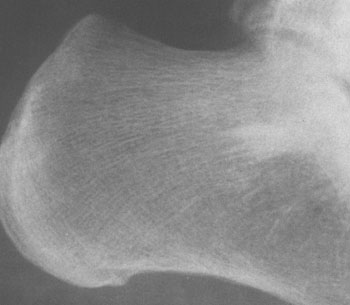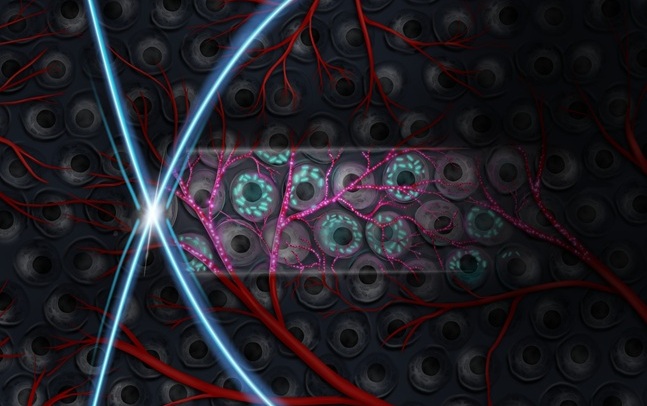CT Attenuation Measurements Can Differentiate Bone Tumors
|
By MedImaging International staff writers Posted on 31 Aug 2016 |

Image: A calcaneous bone with a benign enostosis (Photo courtesy of James Wittig).
A new study suggests that computerized tomography (CT) attenuation measurements can be used to distinguish untreated osteoblastic metastases from benign bone lesions.
Researchers at Massachusetts General Hospital (MGH; Boston, USA) conducted a study in 62 patients with 279 sclerotic bone lesions found at CT. The cause of the sclerotic lesions was then assessed histologically, determining there were 126 benign enostoses (bone islands) in 37 patients, and 153 osteoblastic metastases in 25 patients. The researchers then performed an analysis of the CT images to determine sensitivity, specificity, AUC, 95% confidence intervals, and cutoff values of CT attenuation to help differentiate metastases from enostoses.
The researchers concluded that CT attenuation measurements can be used to distinguish untreated osteoblastic metastases from enostoses, and that a mean attenuation of 885 Hounsfield units (HU) and a maximum attenuation of 1,060 HU provide reliable thresholds below which a metastatic lesion is the favored diagnosis. According to the researchers, the detection of metastatic disease is crucial because it allows accurate diagnosing and determination of prognosis and can drastically change treatment. The study was published in the August 2016 issue of the American Journal of Roentgenology.
“While imaging has become an integral part of diagnosing patients presenting with malignancy, it can be confusing when an osteoblastic lesion is identified in the presence and absence of a primary malignancy,” concluded lead author Connie Chang, MD, of the MGH department of radiology, and colleagues. “As CT use has increased, the frequency of incidentally detected lesions has also increased.”
The Hounsfield scale is a quantitative scale for describing radiodensity, in which distilled water at standard pressure and temperature is defined as zero HU, while the radiodensity of air under the same conditions is defined as -1000 HU; one HU represents a change of 0.1% of the attenuation coefficient of water. A practical application of this is in evaluation of tumors, wherein an adrenal tumor with a radiodensity of less than 10 HU is rather fatty in composition and almost certainly benign.
Related Links:
Massachusetts General Hospital
Researchers at Massachusetts General Hospital (MGH; Boston, USA) conducted a study in 62 patients with 279 sclerotic bone lesions found at CT. The cause of the sclerotic lesions was then assessed histologically, determining there were 126 benign enostoses (bone islands) in 37 patients, and 153 osteoblastic metastases in 25 patients. The researchers then performed an analysis of the CT images to determine sensitivity, specificity, AUC, 95% confidence intervals, and cutoff values of CT attenuation to help differentiate metastases from enostoses.
The researchers concluded that CT attenuation measurements can be used to distinguish untreated osteoblastic metastases from enostoses, and that a mean attenuation of 885 Hounsfield units (HU) and a maximum attenuation of 1,060 HU provide reliable thresholds below which a metastatic lesion is the favored diagnosis. According to the researchers, the detection of metastatic disease is crucial because it allows accurate diagnosing and determination of prognosis and can drastically change treatment. The study was published in the August 2016 issue of the American Journal of Roentgenology.
“While imaging has become an integral part of diagnosing patients presenting with malignancy, it can be confusing when an osteoblastic lesion is identified in the presence and absence of a primary malignancy,” concluded lead author Connie Chang, MD, of the MGH department of radiology, and colleagues. “As CT use has increased, the frequency of incidentally detected lesions has also increased.”
The Hounsfield scale is a quantitative scale for describing radiodensity, in which distilled water at standard pressure and temperature is defined as zero HU, while the radiodensity of air under the same conditions is defined as -1000 HU; one HU represents a change of 0.1% of the attenuation coefficient of water. A practical application of this is in evaluation of tumors, wherein an adrenal tumor with a radiodensity of less than 10 HU is rather fatty in composition and almost certainly benign.
Related Links:
Massachusetts General Hospital
Latest General/Advanced Imaging News
- AI-Powered Imaging System Improves Lung Cancer Diagnosis
- AI Model Significantly Enhances Low-Dose CT Capabilities
- Ultra-Low Dose CT Aids Pneumonia Diagnosis in Immunocompromised Patients
- AI Reduces CT Lung Cancer Screening Workload by Almost 80%
- Cutting-Edge Technology Combines Light and Sound for Real-Time Stroke Monitoring
- AI System Detects Subtle Changes in Series of Medical Images Over Time
- New CT Scan Technique to Improve Prognosis and Treatments for Head and Neck Cancers
- World’s First Mobile Whole-Body CT Scanner to Provide Diagnostics at POC
- Comprehensive CT Scans Could Identify Atherosclerosis Among Lung Cancer Patients
- AI Improves Detection of Colorectal Cancer on Routine Abdominopelvic CT Scans
- Super-Resolution Technology Enhances Clinical Bone Imaging to Predict Osteoporotic Fracture Risk
- AI-Powered Abdomen Map Enables Early Cancer Detection
- Deep Learning Model Detects Lung Tumors on CT
- AI Predicts Cardiovascular Risk from CT Scans
- Deep Learning Based Algorithms Improve Tumor Detection in PET/CT Scans
- New Technology Provides Coronary Artery Calcification Scoring on Ungated Chest CT Scans
Channels
Radiography
view channel
AI-Powered Imaging Technique Shows Promise in Evaluating Patients for PCI
Percutaneous coronary intervention (PCI), also known as coronary angioplasty, is a minimally invasive procedure where small metal tubes called stents are inserted into partially blocked coronary arteries... Read more
Higher Chest X-Ray Usage Catches Lung Cancer Earlier and Improves Survival
Lung cancer continues to be the leading cause of cancer-related deaths worldwide. While advanced technologies like CT scanners play a crucial role in detecting lung cancer, more accessible and affordable... Read moreMRI
view channel
Ultra-Powerful MRI Scans Enable Life-Changing Surgery in Treatment-Resistant Epileptic Patients
Approximately 360,000 individuals in the UK suffer from focal epilepsy, a condition in which seizures spread from one part of the brain. Around a third of these patients experience persistent seizures... Read more
AI-Powered MRI Technology Improves Parkinson’s Diagnoses
Current research shows that the accuracy of diagnosing Parkinson’s disease typically ranges from 55% to 78% within the first five years of assessment. This is partly due to the similarities shared by Parkinson’s... Read more
Biparametric MRI Combined with AI Enhances Detection of Clinically Significant Prostate Cancer
Artificial intelligence (AI) technologies are transforming the way medical images are analyzed, offering unprecedented capabilities in quantitatively extracting features that go beyond traditional visual... Read more
First-Of-Its-Kind AI-Driven Brain Imaging Platform to Better Guide Stroke Treatment Options
Each year, approximately 800,000 people in the U.S. experience strokes, with marginalized and minoritized groups being disproportionately affected. Strokes vary in terms of size and location within the... Read moreUltrasound
view channel
Ultrasound-Based Microscopy Technique to Help Diagnose Small Vessel Diseases
Clinical ultrasound, commonly used in pregnancy scans, provides real-time images of body structures. It is one of the most widely used imaging techniques in medicine, but until recently, it had little... Read more
Smart Ultrasound-Activated Immune Cells Destroy Cancer Cells for Extended Periods
Chimeric antigen receptor (CAR) T-cell therapy has emerged as a highly promising cancer treatment, especially for bloodborne cancers like leukemia. This highly personalized therapy involves extracting... Read moreNuclear Medicine
view channel
Novel PET Imaging Approach Offers Never-Before-Seen View of Neuroinflammation
COX-2, an enzyme that plays a key role in brain inflammation, can be significantly upregulated by inflammatory stimuli and neuroexcitation. Researchers suggest that COX-2 density in the brain could serve... Read more
Novel Radiotracer Identifies Biomarker for Triple-Negative Breast Cancer
Triple-negative breast cancer (TNBC), which represents 15-20% of all breast cancer cases, is one of the most aggressive subtypes, with a five-year survival rate of about 40%. Due to its significant heterogeneity... Read moreImaging IT
view channel
New Google Cloud Medical Imaging Suite Makes Imaging Healthcare Data More Accessible
Medical imaging is a critical tool used to diagnose patients, and there are billions of medical images scanned globally each year. Imaging data accounts for about 90% of all healthcare data1 and, until... Read more
Global AI in Medical Diagnostics Market to Be Driven by Demand for Image Recognition in Radiology
The global artificial intelligence (AI) in medical diagnostics market is expanding with early disease detection being one of its key applications and image recognition becoming a compelling consumer proposition... Read moreIndustry News
view channel
GE HealthCare and NVIDIA Collaboration to Reimagine Diagnostic Imaging
GE HealthCare (Chicago, IL, USA) has entered into a collaboration with NVIDIA (Santa Clara, CA, USA), expanding the existing relationship between the two companies to focus on pioneering innovation in... Read more
Patient-Specific 3D-Printed Phantoms Transform CT Imaging
New research has highlighted how anatomically precise, patient-specific 3D-printed phantoms are proving to be scalable, cost-effective, and efficient tools in the development of new CT scan algorithms... Read more
Siemens and Sectra Collaborate on Enhancing Radiology Workflows
Siemens Healthineers (Forchheim, Germany) and Sectra (Linköping, Sweden) have entered into a collaboration aimed at enhancing radiologists' diagnostic capabilities and, in turn, improving patient care... Read more


















